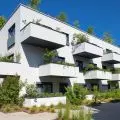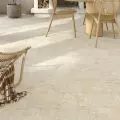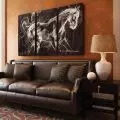Article fromA&B issue10|23
Jacket, chicken-ufo, modular homes. And a lemur. All this (and much more) can be seen at the Museum of the City of Gdynia at the next exhibition in the series "Polish Projects by Polish Designers." This time the protagonist of the exhibition, prepared by curator Anna Sliwa, is one of the most extraordinary figures of domestic design thought - Jakub Szczęsny.
Jakub Szczęsny. Polish Projects Polish Designers
Photo: Bogna Kociumbas-Kos
...and good design for all
We arrived at the Museum of the City of Gdynia a few minutes late. In the entrance hall, a kind security guard nodded in response to our breathless "good morning" and pointed with his hand in the direction of the stairs leading up to the first floor - the curator's tour of the exhibition realized as part of the "Polish Projects Polish Designers" series had already begun. About thirty people of various ages surround Jakub Szczęsny, who talks about his projects, jokes, falls into a series of digressions, from which he bravely returns to the main thread. He talks about issues important to architecture and the world, but has nothing of the prophet of modern design. Instead of the black so favored by architects, he is dressed in a striped navy shirt and a yellow baseball cap. There are no solemn sentences fraught with "palimpsests" and "paradigms," instead there is a drawing depicting a katta lemur with big glasses on its nose - his animal alter ego. The audience snorts with laughter - especially a few children (about eight to ten years old), who catch Szczęsny's words with one ear while looking around for a space to play. And that's a good thing, because the goal of the exhibition's creators was to create a space where all visitors, regardless of age, feel comfortable.
The architecture of the exhibition was created using simple means - concrete blocks, plywood or conveyor belts
Photo: Bogna Kociumbas-Kos
A several-year-old blond boy in a celadon shirt climbs on cubes made of plywood, in which large holes have been cut. They can be used as a seat or a playground. His little friend stares intently at a lemur drawn on the wall explaining the meaning of the word "designer." It's "a person who invents what various objects will look like," says the friendly animal, who must have stepped in a puddle of black paint, because the traces of his paws run throughout the exhibition space. In this way, an educational path has been created for children: they don't have to mess with their heads to read curatorial descriptions that are incomprehensible to them, because the simple lemur message is at their eye level. The exhibition fills a gap in the school curriculum, which completely ignores the fact that from everywhere we are surrounded by objects that were designed by someone. It shows the youngest children this important aspect of reality and explains that design should be done consciously, with respect for the environment.
For Jakub Szczęsny, it is extremely important to involve future users of the object in the design process; this is how the modular, portable Bench was created
photo: Bogna Kociumbas-Kos
The creators of the exhibition also thought about the visually impaired or blind. The composition is based on strong color contrasts (sharp orange is the dominant color), and there are tyflographic plates placed next to the various elements of the exhibition. We all deserve good design. It's our inalienable right, Szczęsny seems to be saying. And design for all!
the exhibition not only tells the story of responsible design, but also exemplifies it; after the finissage and dismantling of the exhibition, individual elements and materials can be reused
Photo: Bogna Kociumbas-Kos
GREAT STUFF
The exhibition at the Museum of the City of Gdynia, despite its light, often humorous narrative, touches on serious and extremely important problems. "Who is destroying the world?" - provokes Szczęsny and immediately points out the (co-)culprits. It's the architects who are engaged in the production of unnecessary PUM (usable residential area). Instead of designing smaller buildings, tailored to our real needs and capabilities, they create scaled-down houses that are 200-300 square meters each. He calls it all a "big hoax."
Many of the realizations are presented in photographs - the visitor is not bored, a huge contribution to this is due to the original and witty descriptions of subsequent objects and their concepts
photo: Bogna Kociumbas-Kos
Instead of domestic gigantomania, he proposes solutions close to those used in Finland, where the most popular single-family house format is 70 square meters. That's as much as can be realized "on notification" in Polish conditions! Meanwhile, the architectural and construction administration bodies of large cities in Poland estimate that "notification" houses account for about 4 percent of all newly built houses.
A fragment of the "Synchronization" light installation, which was created under the Łazienkowski Bridge in Warsaw, has been transferred to the ceiling of the Museum of the City of Gdynia
photo: Bogna Kociumbas-Kos
One alternative is modular houses - such as the Simple House, FreeDOM and Moja Stodoła, designed by Szczęsny. They are modern, with simple forms, and environmentally friendly. I look at mock-ups, floor plans and photos of completed modulars. I find it hard to believe that they could ever dominate the Polish landscape to the extent that the ready-made catalogs have managed to do. More optimism," one visitor pokes me lightly and points to statements from people currently living in houses designed by Jakub Szczęsny. They are happy with the non-obvious choice they made a few years ago.
A mock-up of the Rifle House - when designing this single-family house, the architect had to face the challenge of a plot of land with an unusual shape
photo: Bogna Kociumbas-Kos
utopia? it's real!
Near the photos of the modular homes hangs a white magnetic board. "Take a piece of paper and write down your way of being eco," it - it encourages. I read visitors' ideas noted down on small orange pieces of paper. Someone drew a bicycle. Someone else wrote that he uses the public transport and segregates waste. My favorite, however, is the person who, under "someone else's" way, added "I use other people's cards." It's a statement in the spirit of the exhibition - with a light-hearted wink, but at the same time touching on the extremely important issue of saving raw materials today.
The exhibition breathes optimism. The impossible does not exist - its creators seem to say, and I begin to believe it. A smile appears on my face. Maybe it's thanks to Szczęsny's peculiar sense of humor? Or maybe due to the designer's ability to turn even seemingly utopian ideas into reality? Among such is Warsaw's Keret House, which is Szczęsny's most famous realization. In Gdynia, it has been partially reconstructed on an almost natural scale. You can go inside and see that there is really very (very!) little space. The creator refers to it as a utopia that was made a reality by an official stamp on a permit issued by the Department of Architecture in Wola, Warsaw. One "stamp" was enough for the utopia to become a real entity.
more than architecture
Presented at the exhibition, Szczęsny's output is diverse. Furniture, installations, single-family houses (modular and traditional), press illustrations and a down jacket. It's as if the designer can't make up his mind and choose one path of professional development. Or like the katta lemur, who values freedom above all else, and falls into apathy under conditions of captivity. However, this is only a first impression. Szczęsny is very consistent in his apparent inconsistency.
A glimpse into the future? Jakub Szczęsny argues that it belongs to modular construction
Photo: Bogna Kociumbas-Kos
Each of his projects begins with an understanding of the behavior and emotions of future users - whether they are residents of Wroclaw (Jacob's Ladder), Tel Aviv (Pchechong Installation) or chickens in Saint Louis (Chicken Coop UFO Installation). After all, we are all living beings inhabiting the Earth, and we all need a sense of security and good relations with other representatives of our species. The latter seems especially important for Szczęsny, whose installations often act as generators of social relationships. This is what happened, among others, in the case of The Ladder, which allowed us to take a different perspective on the reality around us - both in the literal sense (it served as a vantage point) and metaphorical sense (it revived the neighborhood community).
Szczęsny's work seems impossible to enclose in a rigid framework - from his hand came, among others, the Frost coat (left) and the "narrowest house in the world" - Keret House (right)
photo: Bogna Kociumbas-Kos
exposition for reuse
Jakub Szczęsny, as he declares, likes to work with simple materials. The exhibition features, among other things, furniture made from Paged's waste plywood (Szczęsny is artistic director at Paged Meble). The arrangement of the exhibition itself surprises with simple yet ingenious technical and material solutions. In addition to the aforementioned elements made of plywood, europallets, cellular concrete blocks (available for purchase at any DIY store) and elements from previous exhibitions carried out by the Gdynia City Museum were used. As a result, the carbon footprint was reduced to a minimum. After the exhibition, all materials will be reusable, the authors declare. They were not permanently joined using glue or mortar, but used conveyor belts.
Ordinary plywood, often a production waste, creates endless possibilities for the designer
Photo: Bogna Kociumbas-Kos
Szczęsny points out that after the Venice Biennale, mountains of trash from dismantled exhibitions and exhibit packaging remain. He therefore proposed that the exhibition's finissage should also become an opportunity to "share" the materials used - anyone will be able to come to the Museum, take a selected piece of exhibition architecture and give it a second life. Perhaps someone will need a few concrete blocks or a conveyor belt?
simple, ingenious, pro-ecological - these three words contain the clou of Szczęsny's work; - modular wooden jewelry boxes designed for Paged
Photo: Bogna Kociumbas-Kos
The tour is over. We go to the museum's terrace, where there is an installation Cloud, made especially for the Gdynia exhibition. The gray-blue tables and stools are shaped like small cumulus. We sit on the clouds, expose our faces to the sun and look at the cloudless sky over the Baltic Sea. Architecture can improve the world, we think, it just needs more lemurs.
***
The exhibition in Gdynia is open until June 2, 2024. It's worth a visit, even if not everyone will be lucky enough to be guided through the exhibition by lemur Jakub Szczęsny himself.
Błażej Ciarkowski
Illustrations courtesy of the Museum of the City of Gdynia.
















































